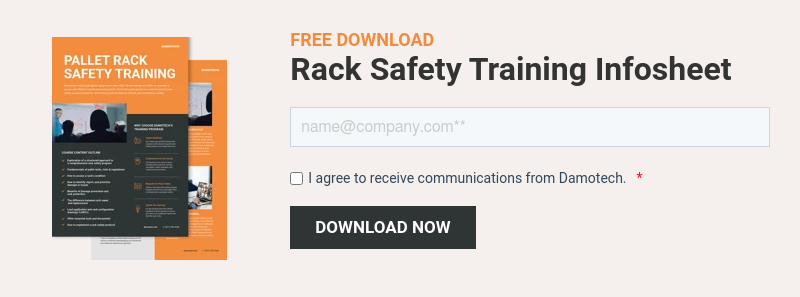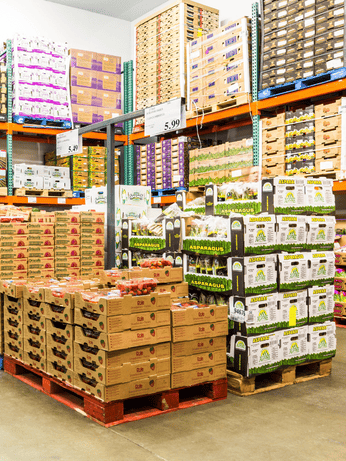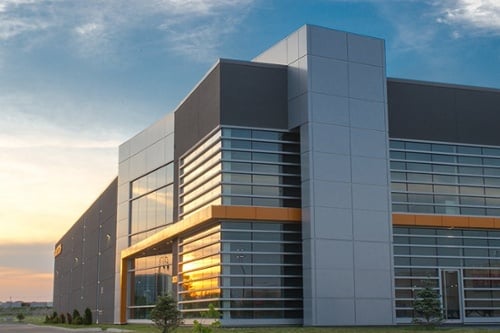What Warehouse Managers Can Learn from Costco’s Genius Warehousing Strategy
Costco Wholesale Corporation has earned its place among the world’s top retailers not just through low prices, but by building one of the most efficient warehousing and supply chain models in the industry. At the heart of Costco’s success is a powerful blend of operational simplicity, high-volume distribution, and layout-driven efficiency—all designed to move product fast and keep costs low.
In this article, we’ll break down the core elements of Costco’s warehouse strategy, exploring how its logistics model, pallet rack usage, and floor layout contribute to speed, safety, and scalability. Whether you manage a warehouse, oversee operations, or handle safety compliance, these insights will help you rethink your own facility for better performance.

Costco’s Unique Warehousing & Supply Chain Approach
Unlike traditional retailers, Costco designs its massive 145,000-square-foot warehouses for bulk selling and high-efficiency operations. Its warehouse strategy emphasizes simplicity over aesthetics, using exposed concrete floors, industrial steel pallet racks, and minimal decor to focus on throughput and value.
With a limited SKU count of around 4,000—compared to over 30,000 in a typical supermarket—Costco simplifies inventory management and accelerates inventory turnover. Fewer SKUs enable Costco to negotiate better volume discounts and move products more efficiently, ultimately passing the savings on to its members.
Interestingly, product placement follows a rotating layout, intentionally designed to create a treasure hunt shopping experience. This not only encourages exploration but also drives unplanned purchases, boosting revenue per visit.
How Low Product Margins Fuel Operational Efficiency
One of Costco’s most distinct advantages is its razor-thin product margin strategy. By capping product markups at just 15%, Costco undercuts competitors while relying on membership fees to drive profitability.
This low-margin model drives high product turnover, reducing the need for long-term storage and allowing Costco to maintain product freshness. It also enables the company to sell luxury items, such as electronics and jewelry, at competitive prices without sacrificing quality.
Efficient warehouse operations, minimal rehandling, and standardized product sizes support this model. Together, these elements make the warehouse a core profit enabler, not just a cost center.
Warehouse Safety: A Key Priority for Costco Management
Costco’s commitment to safety ensures a secure shopping environment for its members, contributing to employee satisfaction and retention. It translates into an efficient and experienced workforce, ultimately contributing to Costco’s successful warehousing approach.
Safety is a paramount concern for Costco, not only for its members but also for its employees. The company has implemented a comprehensive safety program that exceeds industry standards, ensuring a secure shopping environment and employee well-being.

Each warehouse location has a dedicated safety team responsible for maintaining compliance with safety regulations. Regular safety audits and inspections are conducted to identify and rectify potential hazards. Employees receive safety training upon joining the company and undergo continuous on-the-job safety education. Costco also employs ergonomic approaches to its warehouse design, such as reducing employee strain during product handling and implementing safety measures to prevent accidents, including slip-resistant concrete flooring.
Are you trained in warehouse safety? Learn how our rack safety training can help your workers understand potential hazards and know what to do when damage occurs.

Pallet Racks: Enhancing Warehousing Efficiency and Safety in Alignment with Costco’s Business Strategy
Costco’s pallet racks are integral to the company’s warehouse operations and design, facilitating the effective and efficient handling, storage, and display of goods. The steel racks, designed to hold hefty pallets of products, are significantly more extensive and robust than those in a typical grocery store.
Unlike conventional retail stores that stock individual items or smaller cases on shelves, Costco warehouses often present products directly on pallets. These pallets are efficiently placed onto the pallet racks using forklifts or other machinery, reducing the need for stocking items individually and streamlining the restocking process. This practice minimizes labor costs and saves valuable time.
Furthermore, the configuration of these pallet racks maximizes the utilization of storage space within the warehouse. This strategic arrangement enables Costco to store and display a substantial volume of goods in a limited space. By leveraging this high-density storage solution, Costco can effectively purchase and sell bulk, increasing inventory turnover and reducing costs.

Costco’s strategy prioritizes the safe design and installation of its pallet racks, adhering to stringent safety standards. The racks are constructed with sturdiness in mind and undergo regular inspections to ensure they can safely bear the weight of heavy pallets. Safety netting or wire mesh is often employed at the back of the racks to prevent potential accidents by preventing items from falling.
Costco’s pallet racks’ utilitarian and industrial look harmonizes with the company’s no-frill aesthetic. This design approach reinforces Costco’s brand promise of offering high-quality products at affordable prices, emphasizing functionality over ornamental appeal.
Costco’s pallet racks exemplify the company’s commitment to operational efficiency and safety. Costco ensures that each element, from its pallet racking system to all other operational aspects, contributes to its overarching business strategy.

Costco’s Distribution & Supply Chain Strategy
As part of its comprehensive business strategy, Costco employs a distribution strategy that serves multiple purposes, aligning with its marketing and operational objectives. Costco’s warehouses serve as both retail spaces and distribution centers, allowing the company to optimize its supply chain and reduce operating costs.
One significant aspect of Costco’s distribution strategy is its direct-to-consumer model. Instead of relying on separate distribution centers, Costco streamlines its operations by having goods shipped directly from suppliers to warehouses. This approach eliminates the need for intermediaries and reduces storage and transportation costs. By eliminating unnecessary links in the supply chain, Costco can offer competitive prices to its members while maintaining high-quality products.
However, it is essential to note that Costco does operate regional depots as part of its distribution network. These depots act as central hubs, receiving goods from suppliers and efficiently distributing them to nearby Costco warehouses. By strategically locating these depots, Costco minimizes transportation distances and optimizes the flow of goods to meet its customers' demands.
The combination of these operational, strategic, and supply chain efficiencies has shaped Costco’s distribution strategy to success. Costco has revolutionized the retail industry by prioritizing member value and operational excellence and setting a high standard for its competitors. The company’s distribution strategy is a testament to its commitment to delivering exceptional value to its members, offering valuable insights for businesses across various sectors.

What Makes Costco’s Business Strategy a Success?
Costco has established itself as a leader in the retail industry by implementing a warehousing approach that delivers remarkable results. Here are several key factors that contribute to Costco’s success:
1. Membership Model: Costco operates as a membership-only warehouse club, ensuring a steady revenue stream from membership fees. By relying on these fees rather than hefty product markups, Costco can maintain low prices consistently for its members.
2. High Inventory Turnover: Costco’s limited product selection and bulk-selling strategy enable the company to achieve a high inventory turnover rate. Products are sold and replaced quickly, keeping the inventory fresh and reducing storage costs. This agility allows Costco to adapt swiftly to market trends and introduce new or seasonal items as needed.
3. Efficient Operations: Costco’s warehouse design and streamlined processes result in significant cost savings compared to traditional retail models. Products are often sold directly off shipping pallets, simplifying restocking and reducing labor costs. These operational efficiencies enable Costco to pass on savings to its members.
4. Consistent Value: Costco’s commitment to maintaining low prices is a cornerstone of its success. By consistently delivering exceptional value, Costco builds trust and loyalty among its members, driving repeat business.
5. Quality Products: Despite its focus on affordability, Costco does not compromise on product quality. The company’s Kirkland Signature brand is renowned for matching or surpassing the quality of leading national brands. By offering high-quality products at competitive prices, Costco enhances customer satisfaction and reinforces member loyalty.
Four Surprising Facts About Costco Warehouses
1. The Kirkland Signature Brand: Costco members are undoubtedly familiar with the renowned Kirkland Signature brand, encompassing various categories such as clothing, food, and household items. But did you know the brand gets its name from Kirkland, Washington, where the first Costco warehouse was established?
2. Impressive Warehouse Sales: Recent statistics reveal that the average Costco warehouse generates over $160 million in annual sales. This figure significantly surpasses the sales performance of many competitors within the warehouse club industry, underscoring the enduring popularity and success of Costco's warehouse model.
3. The Hot Dog and Soda Deal: Like the legendary rotisserie chicken, Costco’s famous hot dog and soda deal has remained at $1.50 since the mid-1980s. Despite being a loss leader for the company, this demonstrates Costco’s dedication to providing consistent value to its members, ensuring an affordable and satisfying dining option.
4. Costco Gas Stations: In addition to its warehouses, Costco operates gas stations at many locations. These gas stations offer exclusive access to competitive fuel prices, often lower than market rates, adding a different value proposition to the Costco membership.
The Costco Success Story: Revolutionizing Retail Through Innovative Warehousing
In conclusion, Costco’s unparalleled success in the retail industry can be attributed to its strategic warehousing approach, detailed safety protocols, and business strategy that embraces low product margins. Costco has solidified its position as a global retail powerhouse by focusing on simplicity, efficiency, and customer value. The design of its colossal warehouses, combined with the seamless product placement, the membership model, and competitive pricing, create an immersive shopping experience that fosters loyalty among members worldwide.
Additionally, as Costco continues prioritizing safety in its operations, it presents an opportunity for businesses to learn from their commitment. Companies should consider partnering with a rack safety expert to implement or enhance their corporate rack safety program. By prioritizing the safety of employees and customers, businesses can create a secure environment while optimizing their operational efficiency. Embracing Costco’s dedication to safety can be valuable in elevating any organization’s overall performance and reputation in the retail industry and beyond.

About the Costco Distribution Company
Costco is a U.S.-based retail powerhouse. It has become a one-stop shopping destination for millions of members worldwide. Established with a commitment to offering high-quality products at unbeatable prices, Costco has earned a stellar reputation for delivering value to its customers. By leveraging the power of bulk purchasing, Costco passes on significant savings to its loyal members across a diverse range of merchandise, from groceries and electronics to home goods and apparel. Beyond unbeatable deals, Costco has become synonymous with excellent customer service, offering extended and customer-friendly business hours that ensure its members enjoy hassle-free shopping and returns. Whether it's the famous food court, the affordable gas stations, the array of services like travel (including flights, hotels, and vacation packages), optics, photo, pharmacy, insurance, or the Costco-branded credit card with exclusive benefits, Costco remains a retail giant that continues to redefine the concept of value shopping for its members.
Frequently Asked Questions (FAQ)—Costco Warehousing Strategy
What makes Costco’s warehousing model unique?

How does Costco’s limited product selection benefit its supply chain?

How does the membership model support Costco’s low-margin strategy?

What role do pallet racks play in Costco’s efficiency?

How does Costco approach safety for employees and members?

What is Costco’s supply chain and distribution approach?

Why does Costco change product placement frequently?

What are some current facts about Costco’s warehouses?

-
Average sales per warehouse (FY2024): ~$260M.
-
Kirkland Signature was named after the company’s former headquarters, Kirkland, Washington.
-
The $1.50 hot dog + soda deal has been held since the 1980s and remains a protected price point.
-
Fuel operations: Costco ran 719 gas stations at FY2024 year-end; gasoline is a major ancillary that drives trips.
How does Costco balance efficiency with quality?

What can other warehouses learn from Costco?

-
Design for highdensity, low-touch flow (pallet displays, minimal case handling).
-
Institutionalize safety per OSHA warehousing guidance and forklift training under 29 CFR 1910.178.
-
Use cross-dock principles to cut touches and dwell time in your network.











